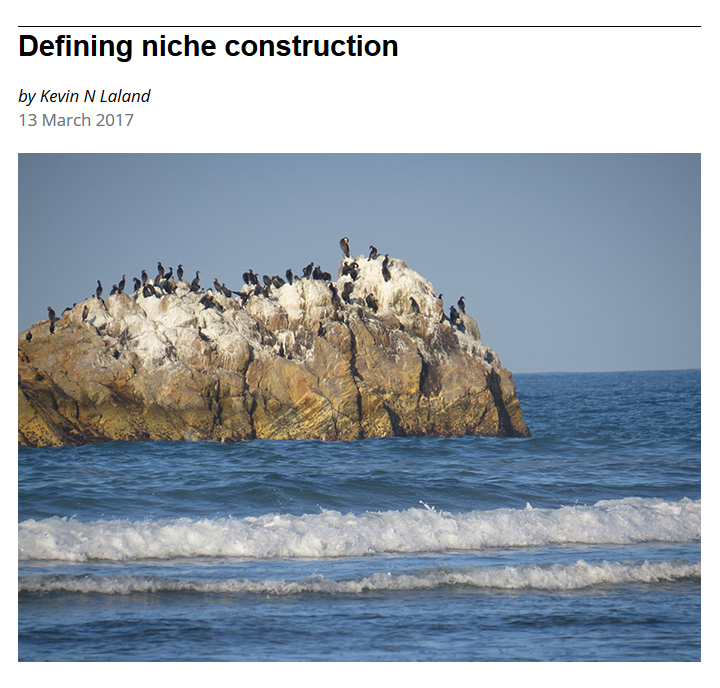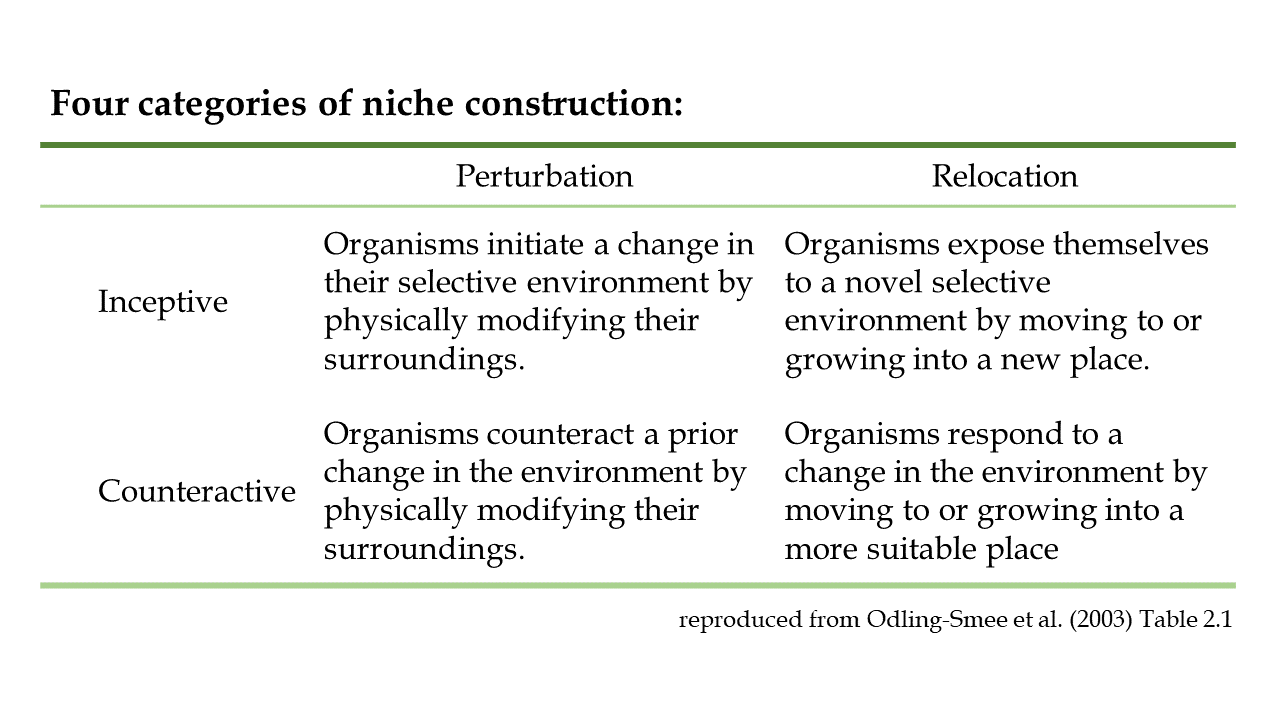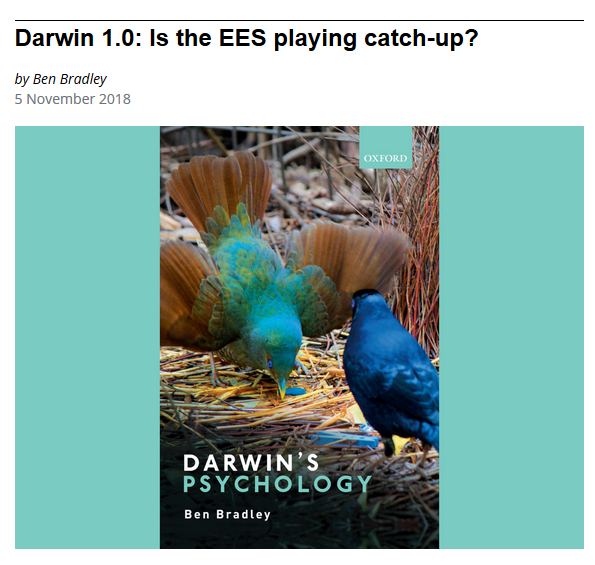The niche construction perspective
The niche construction perspective was originally introduced into evolutionary biology through the pioneering writings of Conrad Waddington and Richard Lewontin. The perspective is encapsulated in the below quote:
The organism influences its own evolution, by being both the object of natural selection and the creator of the conditions of that selection.
From a niche construction standpoint, organisms are viewed as co-directing their own evolution. Through their activities, organisms modify selection acting on themselves and other species that share their environment. Evolution thus entails networks of causation and feedback in which previously selected organisms drive environmental changes, and organism-modified environments subsequently select for changes in organisms (Odling-Smee 1988). Here, environmental modification by organisms (“niche constructionThe process whereby organisms, through their metabolism, their activities, and their choices, modify their own and/or each other’s niches.”), and its legacy over time (“ecological inheritanceThe inheritance, via an external environment, of one or more natural selection pressures previously modified by niche-constructing organisms.”), are explicitly recognized to be evolutionary processes: that is, they cause evolutionary change by acting as sources of modified selection, as well as of modified phenotypes.
However, niche construction is not restricted to the biological adaptations of organisms, but also stems from their developmental plasticity, their by-products, and their acquired characters. Organisms are viewed as active agents that impose order on the conditions of their existence, and direction on their development and evolution.
The niche construction perspective is intellectually aligned with other movements within evolutionary biology, including ‘developmental systems theory’ (Oyama et al., 2001), the active role of behavior in evolution (Bateson, 1988; Duckworth 2009), an emphasis on developmental plasticity (West-Eberhard, 2003), and calls for an extended evolutionary synthesisA new evolutionary framework emphasizing that knowledge of how organisms develop, grow, and interact with environments helps to account for adaptation and the diversity of life. (Laland et al, 2015).
Key readings
Lewontin RC. 1983. Gene, organism, and environment. In: Bendall DS, ed. pp. 273-285. Cambridge: Cambridge University Press This accessible essay introduces the niche construction perspective and critiques conventional evolutionary approaches to adaptation.
Lewontin RC. 2000. The Triple Helix: Gene, Organism, and Environment. Cambridge: Harvard University Press Another readable introduction to the niche-construction perspective by the pioneer of this way of thinking.
Odling-Smee FJ, Laland KN, Feldman MW. 1996. Niche construction. American Naturalist. 147:641–648 A brief, but non-technical, introduction to niche construction for evolutionary biologists.
Odling-Smee FJ, Laland KN, Feldman MW 2003. Niche Construction: The Neglected Process in Evolution. Princeton: Princeton University Press An authoritative, rigorous and extensive introduction to niche construction theory.
Sultan SE 2015. Organism & environment: Ecological development, niche construction, and adaptation. Oxford: Oxford University Press The most up-to-date authoritative and comprehensive treatment of niche construction, packed with empirical examples, particularly in plants and animals.
In this blog post, Kevin Laland explains why niche construction is defined broadly.
Contents
Operational definition of niche construction
The following criteria test for the presence of niche construction (Criteria 1 and 2) and determine when niche construction affects evolution (Criterion 3) (Matthews et al, 2014):
Criterion 1) An organism (i.e., a candidate niche constructor) must significantly modify environmental conditions.
Criterion 2) The organism-mediated environmental modifications must influence selection pressures on a recipient of niche construction.
Criterion 3) There must be a detectable evolutionary response in a recipient of niche construction that is caused by the environmental modification of the niche constructor.
Key readings
Odling-Smee FJ, Laland KN, Feldman MW 2003. Niche Construction: The Neglected Process in Evolution. Princeton: Princeton University Press An authoritative, rigorous and extensive introduction to niche construction theory.
Matthews B, De Meester L, Jones CG, Iberlings BW, Bouma TJ, Nuutinen V, van der Koppel J & Odling-Smee J. 2014. Under niche construction: an operational bridge between ecology, evolution and ecosystem science. Ecological Monographs. 84.2: 245–263. This article clarifies how niche construction and ecosystem engineering can be distinguished, and illustrates how the former can be investigated.
Types of niche construction
Organisms modify the selection that they experience both through physically changing their environments (‘perturbational niche construction’Organisms physically change one or more components of their external environments.) and habitat choice (‘relocational niche construction’Organisms actively move in space, as well as choose or bias the direction, the distance in space through which they travel, and the time when they travel, thereby modifying natural selection.).
Their activities can create novel selection (‘inceptive niche construction’Organisms either perturb their environments, or move, to introduce a new change in one or more natural selection pressures.) or respond to existing selection (‘counteractive niche construction’Organisms either perturb their environments, or move in space, to wholly or partly reverse or neutralise some prior change in their environment.). An additional category, "experiential niche construction,"The modification by organisms of their experience of the environment without changing the environment itself refers to the ways organisms alter their experiences of the environment without changing it.
Perturbational and relocational niche construction
The defining characteristic of niche construction is not organism-driven modification of the environment per se (a special case known as perturbational niche construction), but rather modification of the organism’s niche (that is, modification of the relationship between the organism and its environment). Hence the term ‘niche construction’ includes such cases as dispersal, migration and habitat selection, where organisms relocate in space to modify both the environments that they leave and that they enter (known as relocational niche construction).
Inceptive and counteractive niche construction
If an environmental factor is already changing, or has changed, organisms may oppose or cancel out that change, a process labelled counteractive niche construction. For instance, many wasps and bees will engage in temperature regulation of their nests, heating it up through muscular activity in the cold, and placing droplets of water on the surface, allowing it to cool through evaporation, in the heat. Counteractive niche construction is therefore conservative or stabilizing, and it functions to buffer organisms from shifts in factors away from states to which they have been adapted.
Experiential niche construction
Organisms can also make adjustments that change their experience of the environment, without changing the environment itself (experiential niche construction) (Sultan 2015, Chiu 2019). For instance, penguins huddle to keep warm, whilst plants shift the orientation of their leaves to maximize input from the sun .
Key readings
Odling-Smee FJ, Laland KN, Feldman MW 2003. Niche Construction: The Neglected Process in Evolution. Princeton: Princeton University Press An authoritative, rigorous and extensive introduction to niche construction theory.
Sultan SE 2015. Organism & environment: Ecological development, niche construction, and adaptation. Oxford: Oxford University Press The most up-to-date authoritative and comprehensive treatment of niche construction, packed with empirical examples, particularly in plants and animals.
The history of niche construction research

The scientific study of niche construction dates back to the early writings on ecological succession of William King in the 17th century. There were important 19th century contributions by Charles Darwin (1851) on corals and earthworms (1881), Lewis Henry Morgan (1868) on the beaver, Nathaniel Shaler’s (1892) analyses of how animals affect soils, and Frederic Clements’ (1916) classic work on plant ecological succession.
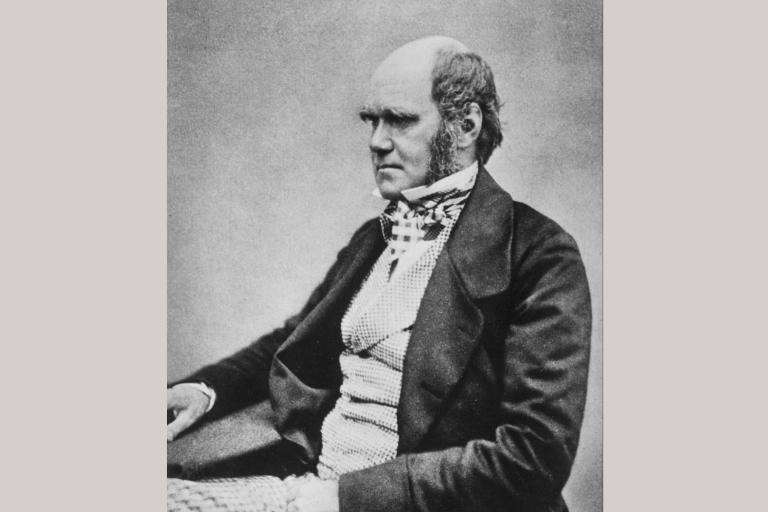
More recently, Niche Construction Theory was brought to prominence through the foundational 20th century work of developmental biologist Conrad Waddington and evolutionary biologists Richard Lewontin and John Odling-Smee. Also influential was the work of Erwin Schrödinger.
Schrödinger and Waddington’s contributions
Nobel prize winning physicist Erwin Schrödinger’s (1944) work already implied that niche construction is universal.
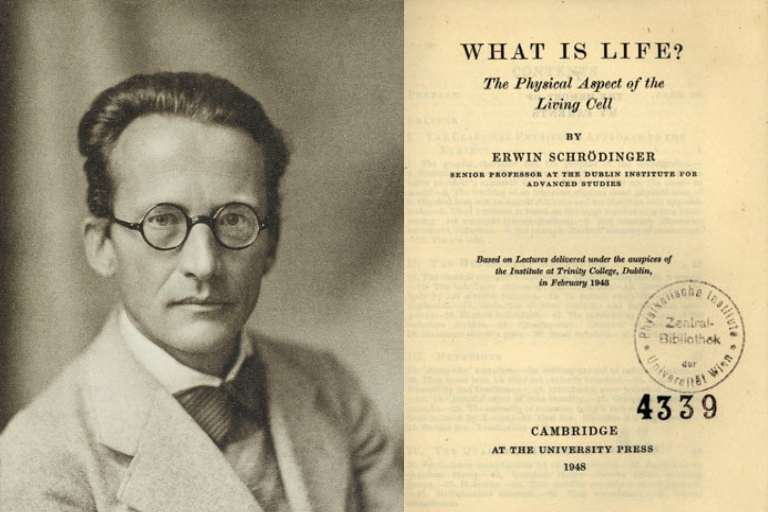
Schrödinger pointed out that living organisms are far-from-equilibrium systems relative to their physical surroundings. To preserve their out-of-equilibrium status, while creating order (structure, organization) in their bodies and their immediate surrounds, Schrödinger emphasized that organisms must actively do work on their environment. In other words, living organisms can only survive by constantly engaging in niche construction. This activity cannot be random: organisms must change environments in systematic, directional ways.
The developmental biologist Conrad Waddington FRS was also an early advocate of the idea. Waddington (1957, 1959) believed that evolutionary theory was incomplete, and suggested that one factor whose significance had not been fully appreciated was niche construction (which he called the exploitive systemThe self-determination by an organism of the nature and intensity of the selective pressures that are exerted on it., the green section in figure below).

He wrote (1959, p1635-6):
Animals … are usually surrounded by a much wider range of environmental conditions than they are willing to inhabit. They live in a highly heterogeneous ‘ambience’, from which they themselves select the particular habitat in which their life will be passed. Thus the animal by its behaviour contributes in a most important way to determining the nature and intensity of the selective pressures which will be exerted on it.
Richard Lewontin’s contribution
Harvard evolutionary biologist Richard Lewontin (1982, 1983, 2000) brought niche construction theory reasoning to prominence within the evolutionary biology community.
His writings stressed how genes, organisms and environments are in reciprocal interaction with each other in such a way that each is both cause and effect (Lewontin, 1983, p281):
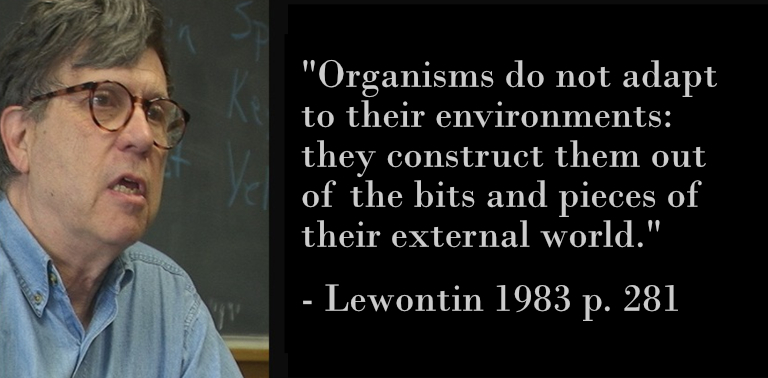
According to Lewontin, this construction process has a number of features:
(1) Organisms determine what is relevant. While stones are part of a thrush’s environment, tree bark is part of a woodpecker’s, and the underside of leaves part of a warbler’s. It is the life activities of these birds that determine which parts of the world, physically accessible to all of them, are actually parts of their environments….
(2) Organisms alter the external world as it becomes part of their environments. All organisms consume resources by taking up minerals, by eating. But they may also create the resources for their own consumption, as when ants make fungus farms, or trees spread out leaves to catch sunlight….
(3) Organisms transduce the physical signals of the external world. Changes in external temperature are not perceived by my liver as thermal changes but as alterations in the concentrations of certain hormones and ions….
(4) Organisms create a statistical pattern of environment different from the pattern in the external world. Organisms, by their life activities, can damp oscillations, for example in food supply by storage, or in temperature by changing their orientation or moving. They can, on the contrary, magnify differences by using small changes in abundance of food types as a cue for switching search images. They can also integrate and differentiate. Plants may flower only when a sufficient number of days above a certain temperature have been accumulated.
Lewontin’s stance can be contrasted with the more traditional view, expressed by fellow evolutionary biologist George Williams (1992):
Adaptation is always asymmetrical; organisms adapt to their environment, never vice versa.
However, while Lewontin’s articles focused attention on niche construction, they were generally interpreted as a critique of adaptationism, and it was not apparent to most biologists how these ideas could be translated into practical science.
John Odling-Smee and beyond
Oxford biologist John Odling-Smee (1988) was the first person to coin the term niche construction, and the first to make the argument explicit that niche construction should be recognized as an evolutionary process. Odling-Smee (1988) also introduced the concept of ecological inheritanceThe inheritance, via an external environment, of one or more natural selection pressures previously modified by niche-constructing organisms..

Together with Kevin Laland and Marcus Feldman, Odling-Smee began the first systematic investigation of niche construction. The team documented and categorized the extent of niche construction in living organisms, devised methods by which its ecological and evolutionary consequences could be investigated, and derived dedicated theory to explore these questions (Odling-Smee et al. 1996, 2003; Laland et al. 1996, 1999).
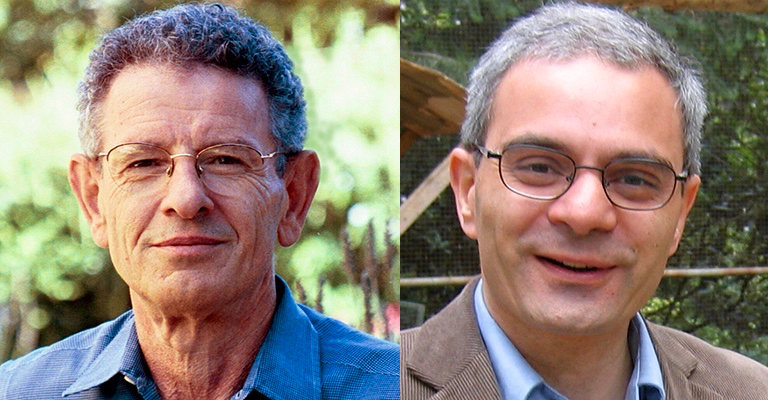
Niche construction theory gained prominence amongst evolutionary biologists and ecologists with Odling-Smee et al.’s influential monograph Niche Construction: The Neglected Process in Evolution (2003). The study of ecosystem engineeringThe modification by organisms of physical surroundings (e.g., light environment, physical habitat structure) so as to modulate the availability of resources or energy fluxes in an ecosystem (a concept that overlaps with niche construction) took off in the mid 1990s (Jones et al. 1994, 1997Jones & Lawton 1995) within ecosystem ecology, adding to the momentum to investigate the effects of organisms on environments.
Additional attempts to model niche construction, and explore its ecological and evolutionary ramifications, followed (e.g. Lehmann 2008; Kylafis & Loreau 2008; van Dyken & Wade 2012). Over the next decade research into niche construction increased rapidly, with a large number of experimental and theoretical studies across a broad range of fields. Several influential academic books make niche construction a central concept.

In 2015, evolutionary ecologist Sonia Sultan published Organism & Environment: Ecological Development, Niche Construction, and Adaptation. Sultan documents extensive evidence for niche construction and its evolutionary consequences, across a wide variety of taxa, and develops the concept of niche construction in important respects.

Key readings
Schrödinger E. 1944/2012. What is Life? With Mind and Matter and Autobiographical Sketches. Cambridge University Press: Cambridge UK. This accessible essay illustrates how Schrodinger was a pioneer of the niche constructive perspective.
Waddington CH. 1959 Evolutionary systems – animal and human. Nature 183:1634-1638. Waddington was ahead of his time in recognizing the importance of niche construction (which he called the ‘exploitative system’) for the evolutionary process.
Lewontin R. 1983. Gene, organism, and environment. In Evolution: From Molecules to Men, ed DS Bendall, pp. 273–85. Cambridge: Cambridge University Press. This accessible essay introduces the niche construction perspective and critiques conventional evolutionary approaches to adaptation.
Odling-Smee, F.J. Niche constructing phenotypes. In. H.C. Plotkin, ed., The Role of Behavior in Evolution, 73-132. Cambridge: MIT Press. Here Odling-Smee first makes the argument that niche construction should be recognized as an evolutionary process, and introduces the concept of ‘ecological inheritance.’
Related concepts
Niche construction overlaps with several other concepts deployed within ecology and evolution (Odling-Smee et al, 2003). Three of these are particularly noteworthy: ecosystem engineering, eco-evolutionary dynamics, and the extended phenotype.
Ecosystem Engineering
Niche construction and ecosystem engineering are related ideas that arose independently in separate fields (niche construction in evolutionary biology, and ecosystem engineering in ecology), but which both place emphasis on changes that organisms make in environments.
Ecosystem engineers are organisms that modify their physical surroundings (e.g., light environment, physical habitat structure) so as to modulate the availability of resources or energy fluxes in an ecosystem (Jones et al. 1994, 1997). By comparison, niche constructors are organisms that alter selection pressures of a recipient organism by modifying any aspect of the abiotic and biotic environment. While evidence of ecosystem engineering would not constitute evidence of niche construction, nonetheless ecosystem engineers are excellent candidates for being niche constructors, particularly when they generate persistent ecosystem effects (Matthews et al, 2014).
In recent times, the two fields have been regarded as complementary and mutually reinforcing, with much cross-citation, and joint publications (e.g. Odling-Smee et al, 2013; Matthews et al, 2014).
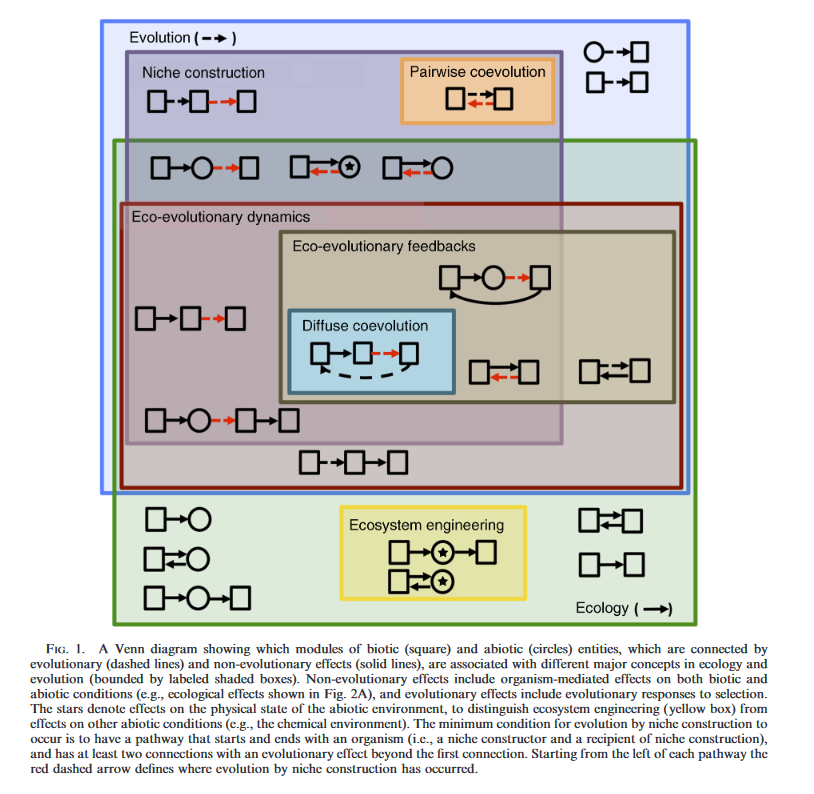
Eco-evolutionary dynamics
Eco-evolutionary dynamics has a very broad focus that includes both the ecological and evolutionary responses of populations to interactions between organisms and their environments (Fussmann et al. 2007, Post & Palkovacs 2009). Evolution by niche construction is closely related to eco-evolutionary dynamics but the two concepts have different emphases. Eco-evolutionary dynamics must include at least two organisms and at least one evolutionary and one ecological effect, whilst neither of these conditions is necessary for evolution by niche construction (Matthews et al 2014). This means there are cases of evolution by niche construction that do not constitute eco-evolutionary dynamics.
Matthews et al (2014) emphasize that while some of the potential mechanisms of niche construction are well-studied, others are not, and that niche construction has value in drawing attention to these gaps. Several research areas in ecology and evolution could be expanded to test for new examples of evolution by niche construction by measuring evolutionary responses of organism-mediated environmental modifications.
The extended phenotype
Extended phenotypes are adaptations expressed outside of the body of the constructor, such as birds’ nests or termites’ mounds (Dawkins 1982). ‘Extended phenotype’ is a narrower term than niche construction, because it is restricted to forms of environmental modification that are biological adaptations.
In contrast, niche construction theory emphasizes that niche construction also incorporates evolutionary by-products that trigger evolutionary episodes. This is vital, since in ecosystems the ecological and evolutionary consequences that flow from niche-constructing by-products are likely to be as substantial as those flowing from niche-constructing adaptations.
Extended phenotypes also exclude aspects of niche construction that depend on acquired knowledge, for instance, human cultural processes. This is an important limitation for scholars of anthropogenic change, since very little human niche construction can accurately be characterized as a biological adaptation.
Finally, the environmental modifications produced by niche-constructing organisms, such as beaver’s dams or termite mounds, may persist through repetition and reconstruction for longer than the individual constructors, and may continue to modulate the impact of these effects on subsequent generations of the same or other populations, a legacy described as an ‘ecological inheritance’.
Theoretical models have shown that niche-constructing by-products, cultural niche construction and ecological inheritance can all strongly affects evolutionary dynamics (Laland et al 1999, 2001; Lehmann 2007, 2008; Creanza & Feldman, 2014).
Further distinctions between niche construction and the extended phenotype are discussed here.
Conceptual change
Over-and-above the aforementioned distinctions, niche construction theory differs from the study of ecosystem engineering, eco-evolutionary dynamics, and the extended phenotype in suggesting that niche construction is an evolutionary process.
Niche construction theory emphasizes how niche construction can scale up across individuals in populations and over time to generate stable and directional modification of environmental components. As a result, niche construction generates consistent and sustained forms of natural selection, and thereby imposes biases on evolution (Laland et al, 2015).
Niche construction theory can be viewed as part of a wider movement that embraces a broader conception of evolutionary causation. For further discussion, see Niche construction and the EES.
Key readings
Schrödinger E. 1944/2012. What is Life? With Mind and Matter and Autobiographical Sketches. Cambridge University Press: Cambridge UK. This accessible essay illustrates how Schrodinger was a pioneer of the niche constructive perspective.
Waddington CH. 1959 Evolutionary systems – animal and human. Nature 183:1634-1638. Waddington was ahead of his time in recognizing the importance of niche construction (which he called the ‘exploitative system’) for the evolutionary process.
Lewontin R. 1983. Gene, organism, and environment. In Evolution: From Molecules to Men, ed DS Bendall, pp. 273–85. Cambridge: Cambridge University Press. This accessible essay introduces the niche construction perspective and critiques conventional evolutionary approaches to adaptation.
Odling-Smee, F.J. Niche constructing phenotypes. In. H.C. Plotkin, ed., The Role of Behavior in Evolution, 73-132. Cambridge: MIT Press. Here Odling-Smee first makes the argument that niche construction should be recognized as an evolutionary process, and introduces the concept of ‘ecological inheritance.’
